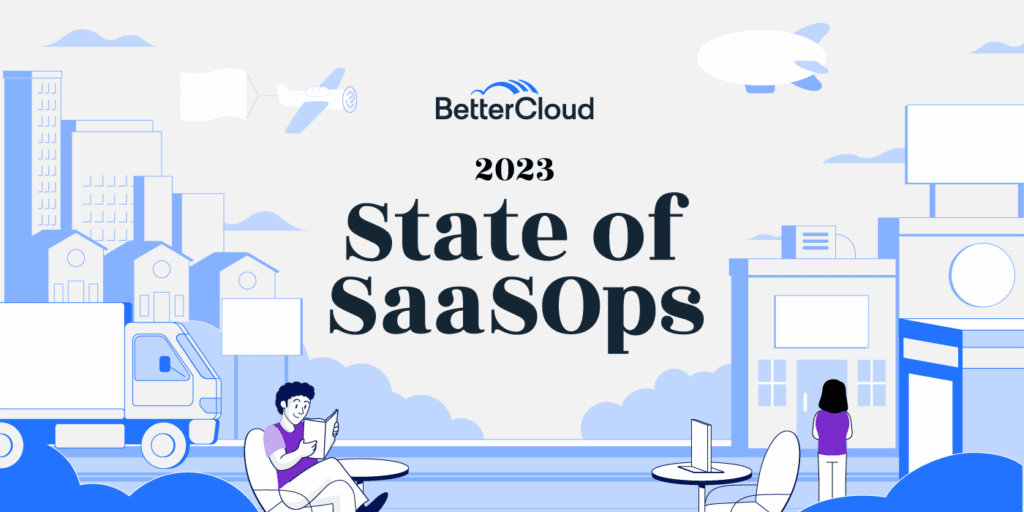79 SaaS statistics in 2021 that will change the way you think about SaaS Management
March 25, 2021
7 minute read

SaaS was always a popular delivery model, but with the accelerating pace of digital transformation, it’s become de rigueur as of late. And as companies around the world rush to adopt SaaS, the need for robust SaaS management has never been clearer.
We rounded up 79 SaaS statistics for 2021 that show the bright future of SaaS, the growing challenges of SaaS management, the power of automation, and more.
SaaS statistics in 2021 show explosive growth of SaaS and all the benefits it brings
We’re seeing businesses adopt SaaS apps at an astounding pace. There’s no going back to legacy systems or the way we worked before—SaaS is here to stay. To demonstrate it, here are some key SaaS statistics for 2021.
1. Businesses today use an average of 80 IT-sanctioned SaaS apps, a 5x increase in just three years and a 10x increase since 2015. (Source)
2. Companies estimate 70% of the business apps they use today are SaaS-based. By 2025, 85% of business apps they use will be SaaS-based. (Source)
3. Gartner’s 2020 I&O Leaders Survey data shows that 70% of organizations are currently investing in SaaS and public cloud offerings and will continue to do so. (Source)
4. Statista predicts that the worldwide SaaS market size will reach $138 billion by 2022, a significant increase over the $101 billion market size it estimated in 2020. (Source)
5. Companies that have adopted cloud platforms report that they can bring new capabilities to market about 20-40% faster. (Source)
6. According to Forrester, 75% of business leaders cite improved business agility and 74% cite speed of implementation and deployment as the benefits that factored into their firm’s decision to move to pure SaaS. (Source)
7. The #1 technology that firms will invest/are investing in to aid digital transformation is SaaS. (Source)
8. According to Gartner, between 2017 and 2022, SaaS spending is expected to increase 241%. (Source)
9. In 2020, annual SaaS revenues now exceed $100 billion, having grown by an average 39% per year over a 10-year period but is only 23% of the total software market. (Source)
10. SaaS makes up a significant portion of total product revenue spend in major application categories:
– 88% of desktop and collaboration apps
– 83% of e-purchasing
– 76% of CRM (Source)
Challenges around discovering, managing, and securing SaaS
Okay, so SaaS is growing exponentially, unabated. But as businesses bet their futures on SaaS, there’s a lot riding on an IT organization’s ability to discover, manage, and secure SaaS environments that may include dozens or even hundreds of apps. Read on for more SaaS statistics for 2021 that you need to know.
Supporting digital transformation and a remote workforce
11. Gartner estimates that by 2024, 70% of IT organizations will lack the relevant roles, skills, and tools to support SaaS-enabled digital transformation. (Source)
12. $1 billion will be spent to support the new extended enterprise by 2022. (Source)
13. Home-based office workers in 2020 increased by almost 18x over 2019. (Source)
Discovering SaaS apps
Shadow IT and SaaS sprawl
14. IBM found that 1 out of 3 employees at Fortune 1000 companies regularly use SaaS apps that haven’t been explicitly approved by internal IT departments.
15. More than three-quarters (76%) of IT professionals see unsanctioned apps as a security risk. (Source)
16. 83% of IT professionals reported that employees stored company data on unsanctioned cloud services. (Source)
17. 80% of workers admit to using SaaS applications at work without getting approval from IT. (Source)
18. 33% of workers downloaded a personal application without IT approval and 36% accessed work applications on a non-work device.
19. Gartner research has found that shadow IT is 30-40% percent of IT spending in large enterprises, and other studies have found it comprises 50% or more. (Source)
20. 48% of people use apps that weren’t distributed by IT, with note-taking apps, project apps, and apps like WhatsApp and Dropbox regularly mentioned. (Source)
21. 67% of organizations said that at least half of technology purchasing is now controlled by business units. (Source)
22. 40% of IT spending takes place outside of the IT department. (Source)
23. 10% of apps are personal and not enterprise, according to BetterCloud Discover trials. (Source)
Redundant apps & wasted spend
24. At any point in time IT operations may be running with 25% or more of software going unused. (Source)
25. Approximately $34 billion in yearly licensing waste is generated each year between the US and UK. (Source)
26. As much as 38% of enterprise software is going to waste. (Source)
27. As many as 67% of app installations are wasted. (Source)
28. 10% of all apps were inactive with no users over 90 days according to BetterCloud Discover trials. (Source)
29. 15% of all apps were inactive with no users over 30 days according to BetterCloud Discover trials. (Source)
30. On average, organizations are likely paying 10-15% more for SaaS licenses than they should. (Source)
31. On average, companies have 135 redundant SaaS apps. (Source)
Managing SaaS apps
Mountains of tedious, labor-intensive tasks
32. 34% of IT teams spend half their week or more manually managing their SaaS environment (Source)
33. Over 40% of information workers spend at least a quarter of their week on repetitive tasks. (Source)
34. Nearly 70 percent of workers say the biggest opportunity of automation lies in reducing time wasted on repetitive work. (Source)
35. IT organizations spend an average of 7.12 hours offboarding a single employee from a company’s SaaS apps, which takes time and energy away from more strategic projects. (Source)
36. IDC estimates over 80% of an organization’s data will be unstructured data, such as documents, presentations, and spreadsheets, by 2025. (Source)
The power of automating manual work
37. In a Forrester study, automating SaaS security management and compliance resulted in a time savings of 20 hours per week. Additionally, risk exposure for documents and accounts was reduced by 50%. (Source)
38. Our research shows that in companies with 200-499 people, automating makes offboarding 136% faster. In companies with 500-999 people, it makes offboarding 151% faster. (Source)
39. 61% of IT professionals use or plan to implement IT automation technology within the next 2 years. (Source)
40. 59% of Fast Movers (top 20% of automation users) report redeploying engineers to higher value activities. (Source)
User lifecycle management: the importance of solid onboarding/offboarding
41. 20% of organizations had data breaches from ex-employees. (Source)
42. 36% of employees continued to have access to systems or data from a former employer after leaving the job. (Source)
43. Employees who felt their onboarding was highly effective are 18x more likely to feel highly committed to their organization. (Source)
44. 91% of those who received effective on boarding feel strong connectedness at work, compared to only 29% of those who had an effective onboarding. (Source)
45. 89% of those who received effective on boarding felt strongly integrated into their culture, compared to 59% of those who received an effective onboarding. (Source)
Securing SaaS apps
46. The top concern that IT professionals have around using SaaS is data security and protection against cybercrime. (Source)
47. Gartner estimates that through 2025, 90% of the organizations that fail to control public cloud use will inappropriately share sensitive data. (Source)
48. Gartner estimates that through 2024, the majority of enterprises will continue to struggle with appropriately measuring cloud security risks. (Source)
49. Gartner estimates that through 2025, 99% of cloud security failures will be the customer’s fault. (Source)
50. 45% of IT professionals say their department does both IT and security, reflecting the blurring lines between the two departments. (Source)
51. A 64% majority of organizations are lacking confidence in the state of their security posture. This is driven by inadequate visibility. (Source)
52. Only 14% of enterprises trust SaaS providers with hosting and managing encryption keys. (Source)
Data breaches & cloud misconfigurations
53. There were 1,001 data breaches in the United States in 2020. Over the course of the same year over 155.8 million individuals were affected by data exposures. (Source)
54. 82% of employees believe it would be possible to access sensitive company information they weren’t authorized to view. (Source)
55. Employees are 85% more likely today to leak files than they were pre-COVID. (Source)
56. File misdelivery (documents and email that ended up with the wrong recipients) ranks 3rd and app misconfiguration ranks 4th in causes of security breaches. (Source)
57. App misconfiguration errors as a source of security breaches within the human error category grew from 20% of errors in 2017 to more than 40% in 2019. (Source)
58. 73% of companies have at least one critical security misconfiguration. (Source)
59. Eight in 10 companies across the United States have experienced a data breach made possible by cloud misconfigurations, according to new research by IDC. (Source)
60. Over 80% of breaches that result from hacking involve brute force attacks (password cracking) or use of lost or stolen credentials. Nearly 90% exploit SaaS apps. (Source)
Visibility, access privileges & data privacy
61. 80% of organizations provide more access privileges than are necessary for users to do their jobs; 17% even say most or all users have too many privileges. (Source)
62. 90% of organizations believe that phishing and ransomware are the top threats facing their organization, but only half have sufficient visibility into these challenges. (Source)
63. 70% of enterprises list transparency on security capabilities as a top characteristic of best-in-class SaaS providers. (Source)
64. 93% of organizations say they must report privacy metrics, like privacy program audit findings, privacy impact assessments, and data breaches to the board. (Source)
Insider threats
65. 75% of IT professionals believe that the biggest security threats lie in cloud storage, file sharing, and email. (Source)
66. 46% percent of IT leaders believe that the rise of SaaS apps makes them the most vulnerable to insider threats. (Source)
67. Less than a third of organizations monitor abnormal user behavior across their cloud footprint. (Source)
68. Well-meaning but negligent end users pose the biggest security threat, according to 62% of IT professionals. (Source)
69. 91% of IT professionals feel vulnerable to insider threats. (Source)
70. 74% of C-level executives don’t think they’ve invested enough to mitigate the risk of insider threats. (Source)
71. 53% of cybersecurity pros say the shift to cloud makes detecting insider attacks more difficult. (Source)
72. 72% of organizations say insider attacks are more frequent over the last 12 months. (Source)
73. 65% of organizations experienced at least one insider attack within the last 12 months. (Source)
74. The average global cost of Insider threats rose by 31% in two years to $11.45 million, and the frequency of incidents grew 47% over the 2 years. (Source)
To learn more about SaaS security, check out our SaaS Data Security Report 2021: Top Risks in File Security.
The future of SaaS usage and management
With SaaS statistics in 2021 showing soaring SaaS adoption and new challenges to grapple with, what does the future hold for SaaS usage and management?
75. Gartner estimates that by 2026, 50% of organizations using multiple SaaS applications will centralize management and usage metrics of these apps using a SaaS management platform (SMP) tool. (Source)
76. 28% of IT leaders are already using some kind of SaaS management tool to get visibility into shadow IT that is necessary to protect their data and systems. (Source)
77. Our research shows that on average, companies are ready to adopt a SaaS management platform once they use 33 SaaS apps. (Source)
78. Through 2024, enhancements in analytics and automatic remediation capabilities will refocus 30% of IT operations efforts, from support to continuous engineering. (Source)
79. Gartner predicts that by 2023’s end, 40% of organizations will have “anywhere operations” to deliver optimized and blended virtual and physical customer and employee experiences. (Source)
To learn more about how BetterCloud can help you discover, manage, and secure your SaaS environment, request a demo.





